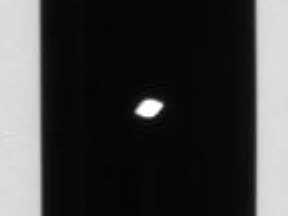Pan (pan, Greek Πάν) is a moon of Saturn, named after the god Pan. It was discovered by Mark R. Showalter in 1990 from analysis of old Voyager probe photos. Pan is within the Encke division in Saturn's A Ring; it acts as a shepherd and is responsible for keeping the Encke gap open. Its gravity produces wave patterns in the rings that indicated Pan's presence and led to the reexamination of Voyager photographs of its predicted location. Other undiscovered moons may exist within Saturn's rings.
 |
|||||||
|---|---|---|---|---|---|---|---|
| Discovery | |||||||
| Discovered by | M. R. Showalter | ||||||
| Discovered in | July 16, 1990 | ||||||
| Orbital characteristics | |||||||
| Semimajor axis | 133,583 km [1] | ||||||
| Eccentricity | 0.00021±0.00008 | ||||||
| Orbital period | 0.5764 d | ||||||
| Inclination | 0.007±0.002° (to Saturn's equator) | ||||||
| Is a satellite of | Saturn | ||||||
| Physical characteristics | |||||||
| Equatorial diameter | 20 km | ||||||
| Mass | 2.7×1015 kg | ||||||
| Mean density | 0.6 g/cm3 | ||||||
| Surface gravity | 0.002 m/s2 | ||||||
| Rotation period | synchronous | ||||||
| Axial tilt | zero | ||||||
| Albedo | 0.5 | ||||||
| Surface temp. |
|
||||||
| Atmosphere | none | ||||||
The existence of such a moon in the Encke division was first predicted by Jeffrey N. Cuzzi and Jeffrey N. Scargle in 1985. Then Showalter et al. inferred its orbit and mass in 1986 by modeling its "wake", or gravitational disturbance. They arrived at a very precise prediction of 133,603 ± 10 km for the semi-major axis and a mass of 510×10−12 Saturn masses, and inferred that there was only a single moon within the Encke gap. [2] [3] The actual semi-major axis is 133,583 km and the mass is 2.7×1015 kg, or 4.7×10−12 of Saturn's mass of 5.688×1026 kg.
The moon was later found within 1° of the predicted position. The search was undertaken by considering all Voyager 2 images and using a computer calculation to predict whether the moon would be visible under sufficiently favorable conditions in each one. Every qualifying Voyager 2 image with resolution better than ~50 km/pixel shows Pan clearly. In all, it appears in eleven Voyager 2 images. [4]
After the discovery it received a temporary designation S/1981 S 13. It is also designated as Saturn XVIII.
There is also an asteroid called 4450 Pan.
References
- Cuzzi, J. N. & Scargle, J. D., "Wavy edges suggest moonlet in Encke's gap", ApJ 292 (1985) 276
- Showalter, M. R., Cuzzi J. N. et al., "Satellite 'wakes' and the orbit of the Encke Gap moonlet", Icarus 66 (1986) 297
- Showalter, M. R., "Visual detection of 1981 S13, Saturn's eighteenth satellite", Nature 351 (June 27, 1991) 709–713
Links
Saturn | Pan | Daphnis | ...
Saturn's natural satellites
Pan | Daphnis | Atlas | Prometheus | S/2004 S 6 | S/2004 S 4 | S/2004 S 3 | Pandora | Epimetheus and Janus | Mimas | Methone | Pallene | Enceladus | Telesto, Tethys, and Calypso | Polydeuces, Dione, and Helene | Rhea | Titan | Hyperion | Iapetus | Kiviuq | Ijiraq | Phoebe | Paaliaq | Skathi | Albiorix | S/2004 S 11 | Erriapo | Siarnaq | S/2004 S 13 | Tarvos | Mundilfari | S/2004 S 17 | Narvi | S/2004 S 15 | S/2004 S 10 | Suttungr | S/2004 S 12 | S/2004 S 18 | S/2004 S 9 | S/2004 S 14 | S/2004 S 7 | Thrymr | S/2004 S 16 | Ymir | S/2004 S 8
see also: Rings of Saturn | Cassini-Huygens | Themis
Retrieved from "http://en.wikipedia.org/"
All text is available under the terms of the GNU Free Documentation License

